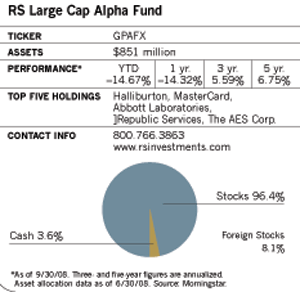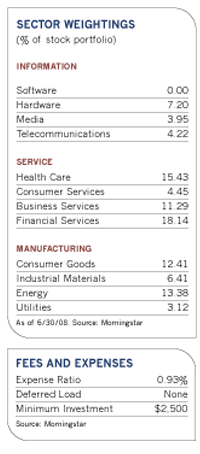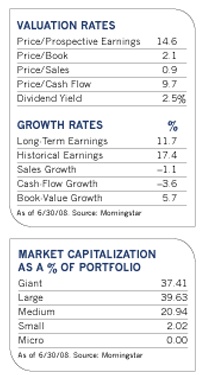Growing up in Brazil in the 1980s, William Landers remembers the hyperinflation that once gripped the country. "People would cash their paychecks and run to the supermarket because they knew by the end of the month their money would be worthless," recalls the 39-year-old manager of the BlackRock Latin America fund. "The clerks had to put new prices on products every day." The inflation rate swelled to 2,500% in 1993, and few could afford to borrow because interest rates were so high.
The inflationary spiral began to ebb in the mid-1990s with the introduction of government reforms, and since 2002, President Luiz Inacio Lula da Silva has successfully restored macroeconomic stability to the region and stepped up social spending to bring the bottom rungs of the population out of poverty. Strong demand for the country's products and a more active export policy have boosted corporate earnings over the last five years and the economy has grown at an average rate of 4.5% since 2004, its fastest rate in 20 years. A growing middle class is waking up to consumer credit and borrowing to buy a variety of goods. But perhaps the most dramatic outgrowth of Brazil's new fiscal stability is its stock market, which soared 44% last year alone.
With average annual returns of about 40% over the five years ending August 31, BlackRock Latin America fund rode the rally. (It returned 20.5% annually over the ten years ending June 30.) The fund has about 73% of its assets in Brazilian companies-roughly a 5% overweight relative to the MSCI Emerging Markets Latin America Index. But the Latin American stock market began to swoon in late May as investors became concerned about the country's slower growth and the impact sliding oil prices may have on Petroleo Brasileiro, Brazil's stock market Goliath that accounts for a large chunk of the domestic market as well as the index. The fund's 19% weighting in Petrobras, while hefty for a mutual fund, is within a few percentage points of the MSCI benchmark.
Over the last five years, the fund has ridden the bull more profitably than many of its peers by training its eye on the buoyant Brazilian market, branching out into less-familiar small-cap and midcap names and making focused bets on some larger undervalued firms with solid fundamentals. It is not unusual for the top ten names to account for 65% to 70% of its assets, and its concentrated nature reflects a loose adherence to a benchmark with a handful of dominant stocks. Typically, Landers will deviate no more than four percentage points from the benchmark's weighting in large-cap names, and no more than two percentage points from midcaps.
Established in 1991, the $939 million fund is one of the oldest of its kind. Landers, who became co-manager in 2002 after spending several years as a Latin America analyst at several investment banks, took over as lead manager in 2004, and he currently has three analysts working with him.
As a Brazil native and longtime Latin America analyst, he has witnessed firsthand both the region's painful political evolution and its notorious stock market volatility. While the recent pullback has raised concerns that the five-year surge may be reversing course, Landers believes the drop does not have the markings of a protracted shift. "With a major correction, you see significant changes in fundamentals. But Brazil has a strong domestic economy and growing demand from an emerging middle class. And the market has traded at twice today's multiples without the solid fundamentals and lower risk that are in place today." He says the Brazilian stock market is trading at an estimated 10 times 2008 earnings and at 9 times 2009 earnings, and he expects earnings to grow more than 30% in 2008 and 20% next year. "You aren't going to find such a strong combination of growth and reasonable valuations in other parts of the world," he maintains. "Latin America's stocks may have higher valuations than they did a couple of years ago, but this isn't the makings of a bubble."
Brazil also has a number of advantages over other BRIC countries, he adds. Overall, its population is wealthier than those in India and China and depends less on foreign oil. Standard & Poor's recently upgraded the country's overseas debt to investment grade, and Brazil's currency and bond markets have had an extended rally. It has better corporate governance standards than the other BRICs, and managers are more open to speaking with investors. IPO listing and reporting requirements are stricter than those in many other parts of the world. Apart from a blip in 2003, inflation has been less than 10% since 1996 and stands at 5% now, about half the level of other emerging markets. And its central bank is careful to set inflation targets and raise interest rates when prices appear to be rising too quickly.
Such governmental restraint is one reason some observers worry about growth prospects for the country's economy. Morgan Stanley economist Marcello Carvalho points out that, despite increased exports over the last three years, the Brazilian economy grew at a pace that fell behind other emerging market economies, and he projects economic growth of 3% in 2009. Landers pegs next year's growth at around 4%, and says that the presidential elections in 2010 could bring fiscal changes that will help the country expand at a faster pace. "I've visited Brazil in the last 18 months and I can tell you that if you didn't turn on the television and listen to the news you wouldn't even know there were concerns about economic growth," he observes.
And despite declining oil prices that recently pummeled Petrobras stock, the company is poised to benefit from recent new discoveries that could increase production dramatically. Brazil's oil reserves were thought to be relatively modest until last year, when the company announced the discovery of the Tupi field, the world's biggest oil find since 2000. Another nearby discovery could hold as much as 33 billion barrels, according to government estimates, which would make it the third-largest field ever found. "Over the next ten years, Petrobras could become one of the top ten oil producers in the world," predicts Landers.
The fund's second-largest holding, Companhia Vale do Rio Doce, or Vale, accounts for about 10% of fund assets. Together, Petrobras and Vale account for a large chunk of the value of Brazil's stock market and about 30% of the fund's net assets. The world's largest producer of iron ore, Vale posted a record net profit of $5 billion in its second quarter, up 22% from the previous year, and the acquisition of Canadian nickel miner Inco in 2006 brought the company closer to its goal of producing all the materials needed to make steel. Landers says Vale produces a higher grade of iron ore than its competitors, and that supply will probably not catch up with demand for another couple of years.
Much of Vale's future hinges on world demand for iron ore and steel, which has slowed recently along with worldwide economies. "If there is a substantial fall in commodity prices, Vale and Petro will most certainly suffer along with the rest of the commodity market," says Landers. "But the fund is positioned with a substantial portion of holdings in stocks that are geared towards their respective domestic economies, which should serve as a counterbalance to our cyclical commodity holdings."
To round out the roster of commodity-driven plays, Landers has beefed up positions in a number of other more domestically driven sectors such as financials, which account for nearly 21% of assets, a seven-percentage-point increase from the end of last year. Recently, he picked up shares of Brazil's three largest banks, which are getting more business from a growing middle class and from the increasing use of mortgages and consumer loans. Until recently, many people either could not afford homes or paid cash for them because interest rates were too high for affordable borrowing. Landers figures Brazilian developer Cyrela, a fund holding, should be one beneficiary of increasing home ownership.
Telecommunication companies account for about 9% of assets, with most of that in the stock of America Movil, a leading Mexican wireless provider that continues to show strong subscriber growth. But because of Mexico's heavy dependence on exports to the recession-bound U.S., Landers has a below-benchmark weighting in the country and recently eliminated cement producer Cemex from the portfolio as a result of continued negative news regarding the U.S. and Spanish housing markets. Last year, an overweight position in Mexico's home-building sector hurt the fund's performance as the sector traded down along with U.S. home builders. Landers also believes that valuations are not very compelling, with Mexico's stocks selling at an average of 12 times estimated 2009 earnings, and projected earnings growth in the 10% to 12% range.
The fund also has a smattering of holdings in Argentina, Chile, Colombia and Peru, with the latter market emerging as one with interesting growth potential. "Even though Peru's stock market has liquidity issues, the economy is growing nicely and the country has inflation under control," he says.












